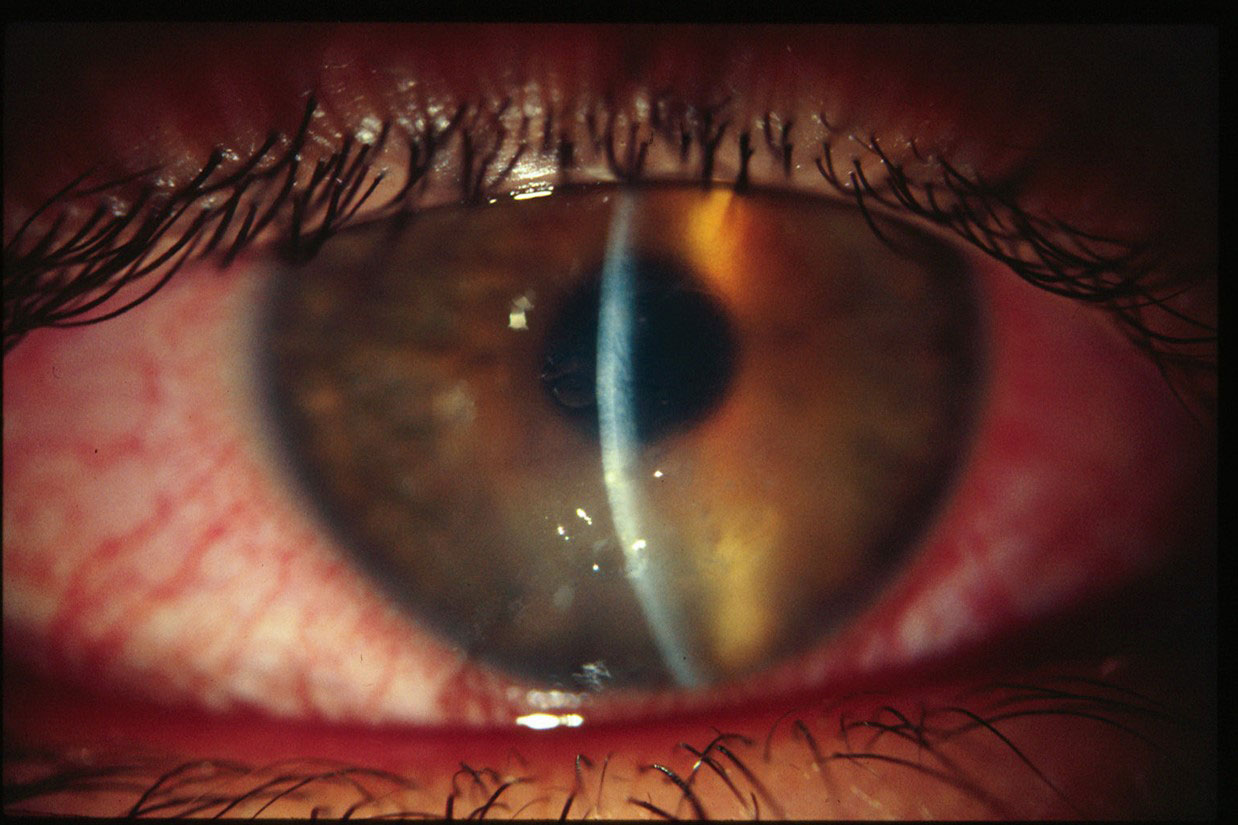 |
Q:
I recently saw a 38-year-old woman with a long history of recurrent corneal erosion (RCE) well-controlled with Muro 128 drops (sodium chloride 5%, Bausch + Lomb). A month ago, she began experiencing excruciating pain again. What’s going on?
A:
“Severe eye pain upon waking is a symptom with a relatively small differential, and first on that list is RCE,” says Aaron Bronner, OD, of Pacific Cataract and Laser Institute. It’s thought that RCE is caused by irregularities in the extracellular architecture that keeps normal epithelial cells firmly adherent to their neighboring cells. Aberrant and absent anchoring junctions make the corneal epithelium more prone to sloughing. This results in both macroform RCE—large erosions that typically require medical management—and the smaller and self-limiting microform RCE.
 |
|
RCE may recur after the epithelium has healed. Click image to enlarge. |
Vicious Cycle
Though shearing forces to the epithelium occur with each blink, epithelial sloughing with RCE is most common at night. This is likely due to a combination of subtle epithelial edema from lid closure during sleep and decreased tear turnover at night. Then, during REM sleep or upon waking, the epithelium is eroded and the patient experiences marked pain, photophobia and lacrimation.
“This process creates a vicious cycle where the epithelium heals within hours or days, but anchoring filament reorganization takes as long as a few months,” Dr. Bronner says. “This results in periods where the patient may feel normal, but the epithelium can slough again without warning, and the process begins again.” In cases caused by scars or dystrophies, the anchoring filaments may never fully recover without surgical intervention.
If the patient goes through a window of two to three months without recurrence, they may never have another episode. But for those who recur or whose case arises from a traumatic or dystrophic source, the potential for recurrence persists for years.1
Management Options
To heal the acute epithelial defect, consider debridement and either a bandage soft contact lens (BSCL) or an amniotic membrane (AM). “Pair either of these with topical antibiotics while the epithelial defect is present,” Dr. Bronner says. Once the defect heals, he recommends continuing BSCL use for as long as three months.
Given its role in promoting corneal wound healing and its anti-inflammatory effects, an AM may be even more effective in the acute stage of the disease than a BSCL.2 However, it would probably need to be replaced with a bandage lens following initial AM removal when the epithelium has healed to support anchoring junction development.
Our patient had stopped the Muro 128 a month prior because she no longer found it available. A few weeks later, she began experiencing the same pain that first brought her in. “Eventually many patients will, whether directed to or not, discontinue the ‘salt water,’” Dr. Bronner warns. “Some of these patients may never have another episode, but in cases like our patient, RCE recurs shortly after cessation.” While she was in the office, we confirmed that both the Muro drops and ointment were available online. She restarted therapy and has since experienced total relief.
For those patients wishing to come off conservative therapy, anterior stromal micropuncture (ASP), debridement with diamond burr polishing (DBP) and phototherapeutic keratectomy (PTK) may be considered in select cases. “My personal experience is that ASP and DBP have higher rates of recurrence following their use,” Dr. Bronner says. “So, I currently recommend PTK for cases not curable with conservative management.”
As with all problems, there is no one RCE treatment that’s right for everyone. For those considering surgical intervention, the risks of pain, infection, poor wound healing and corneal scarring will have to be balanced with how they perceive conservative therapy’s effectiveness or inconvenience.
Dr. Ajamian is the center director of Omni Eye Services of Atlanta. He currently serves as general chairman of the education committee for SECO International. He has no financial interests to disclose.
| 1. Das S, Seitz B. Recurrent corneal erosion syndrome. Surv Ophthalmol. 2008;53(1):3-15. 2. Dua H, Gomes JAP, King AJ, Maharajan VS. The Amniotic membrane in ophthalmology. Surv Ophthalmol. 2004; 49(1):51-77. |

